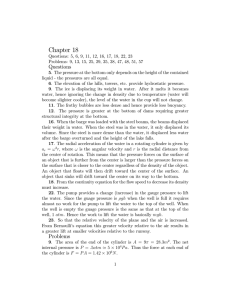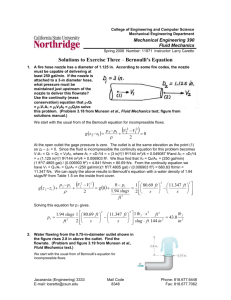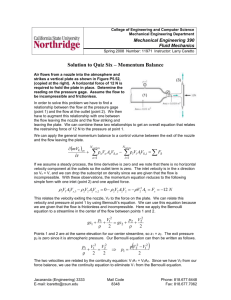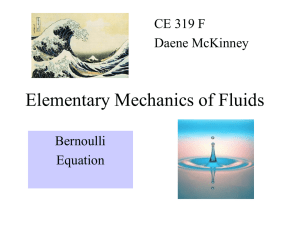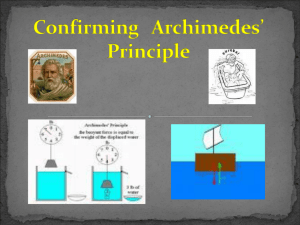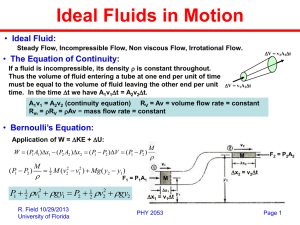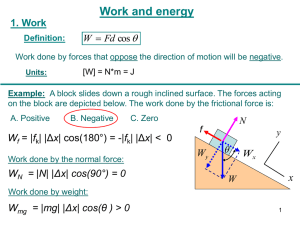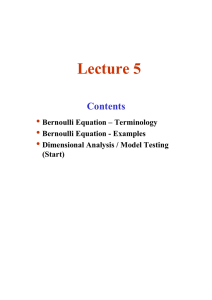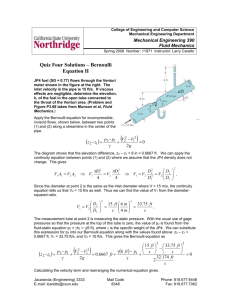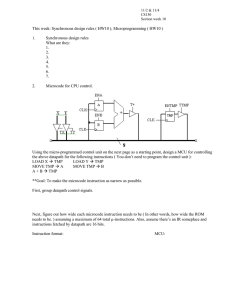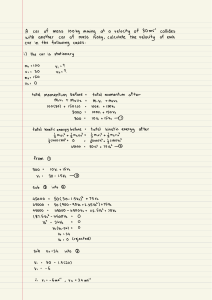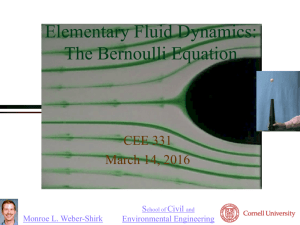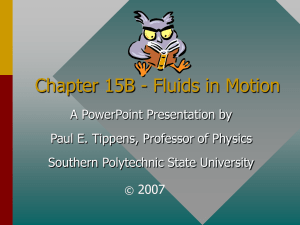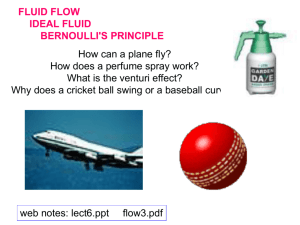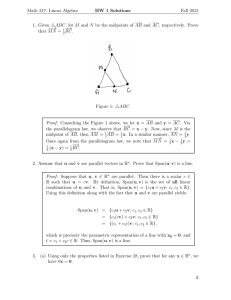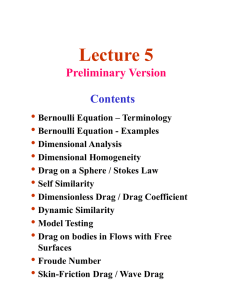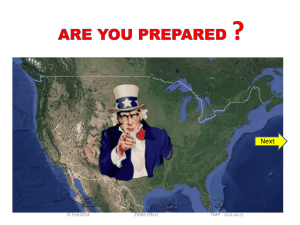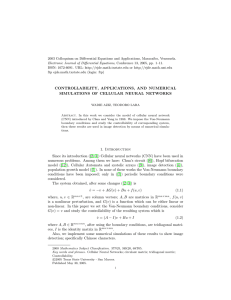Bernoulli Equation → P1+ ½ ρ v1 2 + ρ g y1 = constant
advertisement
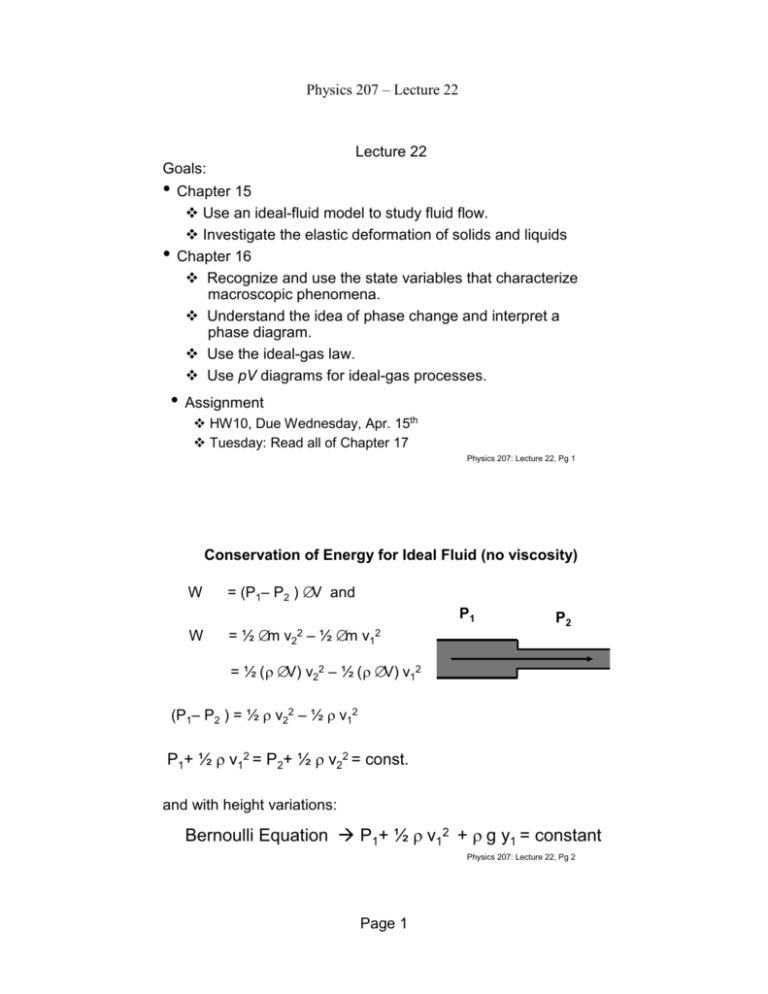
Physics 207 – Lecture 22 Lecture 22 Goals: • Chapter 15 Use an ideal-fluid model to study fluid flow. Investigate the elastic deformation of solids and liquids • Chapter 16 Recognize and use the state variables that characterize macroscopic phenomena. Understand the idea of phase change and interpret a phase diagram. Use the ideal-gas law. Use pV diagrams for ideal-gas processes. • Assignment HW10, Due Wednesday, Apr. 15th Tuesday: Read all of Chapter 17 Physics 207: Lecture 22, Pg 1 Conservation of Energy for Ideal Fluid (no viscosity) W = (P1– P2 ) ∆V and W = ½ ∆m P1 v22 – ½ ∆m P2 v12 = ½ (ρ ∆V) v22 – ½ (ρ ∆V) v12 (P1– P2 ) = ½ ρ v22 – ½ ρ v12 P1+ ½ ρ v12 = P2+ ½ ρ v22 = const. and with height variations: Bernoulli Equation P1+ ½ ρ v12 + ρ g y1 = constant Physics 207: Lecture 22, Pg 2 Page 1 Physics 207 – Lecture 22 Human circulation: Vorp et al. in Computational Modeling of Arterial Biomechanics This (plaque) is a serious situation, because stress concentration within the plaque region increases the probability of plaque rupture, which can lead to a sudden, catastrophic blockage of blood flow. As atherosclerosis progresses, the buildup of plaque can lead to a stenosis, or partial blockage, of the arterial lumen. Blood flowing through a stenosis experiences a pressure decrease due to the Bernoulli effect, which can cause local collapse of the artery and further stress concentration within the artery wall. Physics 207: Lecture 22, Pg 3 Cavitation In the vicinity of high velocity fluids, the pressure can gets so low that the fluid vaporizes. Physics 207: Lecture 22, Pg 4 Page 2 Physics 207 – Lecture 22 Bernoulli’s Principle A housing contractor saves some money by reducing the size of a pipe from 1” diameter to 1/2” diameter at some point in your house. v1 v1/2 2) What is the pressure in the 1/2” pipe relative to the 1” pipe? (A) smaller (B) same (C) larger Physics 207: Lecture 22, Pg 5 P0 = 1 atm Torcelli’s Law d The flow velocity v = (gh)½ where h is the depth from the top surface P + ρ g h + ½ ρ v2 = const d d A B A B P0 + ρ g h + 0 = P0 + 0 + ½ ρ v2 2g h = v2 d = ½ g t2 t = (2d/g)½ x = vt = (2gh)½(2d/g)½ = (4dh)½ Physics 207: Lecture 22, Pg 6 Page 3 Physics 207 – Lecture 22 Applications of Fluid Dynamics Streamline flow around a moving airplane wing Lift is the upward force on the wing from the air Drag is the resistance The lift depends on the speed of the airplane, the area of the wing, its curvature, and the angle between the wing and the horizontal But Bernoulli’s Principle is not applicable (open system). higher velocity lower pressure lower velocity higher pressure Note: density of flow lines reflects velocity, not density. We are assuming an incompressible fluid. Physics 207: Lecture 22, Pg 7 Some definitions Elastic properties of solids : Young’s modulus: measures the resistance of a solid to a change in its length. F L0 Y = elasticity in length ∆L tensile stress F / A0 = tensile strain ∆ L / L0 Bulk modulus: measures the resistance of solids or liquids to changes in their volume. B=− F / A0 ∆ V / V0 volume elasticity V0 F V0 - ∆V Physics 207: Lecture 22, Pg 8 Page 4 Physics 207 – Lecture 22 Carbon nanotube 100 x 1010 Physics 207: Lecture 22, Pg 9 Unusual properties of water If 4° C water is cooled to freezing temperature in a closed, rigid container what is the net pressure that develops just before it freezes? B = 0.2 x 1010 N/m2 and ∆V / V0 = -0.0001 B=− F / A0 ∆ V / V0 0.2 x 1010 N/m2 = P / 0.0001 2 x 105 N/m2 = P = 2 atm Note: Ice B = 9 x 109 N/m2 and the density is 920 Kg/m3 P = 0.08 x 9 x 109 N/m2 or 7 x 108 N/m2 = 7000 atm Physics 207: Lecture 22, Pg 10 Page 5 Physics 207 – Lecture 22 Fluids: A tricky problem A beaker contains a layer of oil (green) with density 2 floating on H2O (blue), which has density 3. A cube wood of density 1 and side length L is lowered, so as not to disturb the layers of liquid, until it floats peacefully between the layers, as shown in the figure. What is the distance d between the top of the wood cube (after it has come to rest) and the interface between oil and water? Hint: The magnitude of the buoyant force (directed upward) must exactly equal the magnitude of the gravitational force (directed downward). The buoyant force depends on d. The total buoyant force has two contributions, one from each of the two different fluids. Split this force into its two pieces and add the two buoyant forces to find the total force Physics 207: Lecture 22, Pg 11 Fluids: A tricky problem A beaker contains a layer of oil (green) with density 2 floating on H2O (blue), which has density 3. A cube wood of density 1 and side length L is lowered, so as not to disturb the layers of liquid, until it floats peacefully between the layers, as shown in the figure. What is the distance d between the top of the wood cube (after it has come to rest) and the interface between oil and water? Soln: Fb = W 1 = 1 V1 g = = Fb2 + Fb3 1 ( 1 = 2 d L2 g + L = 2 d + 3 (L-d) L =( 2 - - 3) 3 1 L3 g (L-d) L2 g 3) d Physics 207: Lecture 22, Pg 12 Page 6 Physics 207 – Lecture 22 Lecture 22 • Assignment HW10, Due Wednesday, Apr. 15th Tuesday: Read all of Chapter 17 Physics 207: Lecture 22, Pg 13 Page 7
